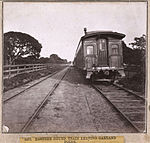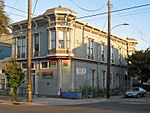Independent Iron Works
1920s establishments in CaliforniaIronworks and steel mills in the United StatesManufacturing companies based in Oakland, California
Independent Iron Works (IIW) was an Oakland, California headquartered steel fabricator founded in the 1920s by William G. Meagher from Port Angeles, Washington, later co-owned with Henry F. Gede, of Oakland. Secondary facilities were located in Los Angeles, California.
Excerpt from the Wikipedia article Independent Iron Works (License: CC BY-SA 3.0, Authors).Independent Iron Works
Pine Street, Oakland West Oakland
Geographical coordinates (GPS) Address Nearby Places Show on map
Geographical coordinates (GPS)
| Latitude | Longitude |
|---|---|
| N 37.8098 ° | E -122.3033 ° |
Address
Pine Street 840
94607 Oakland, West Oakland
California, United States
Open on Google Maps







